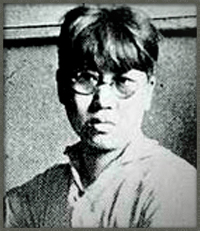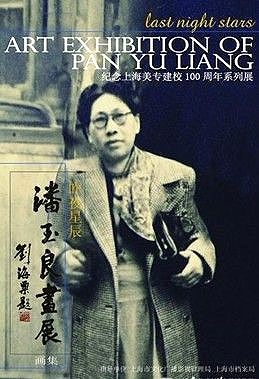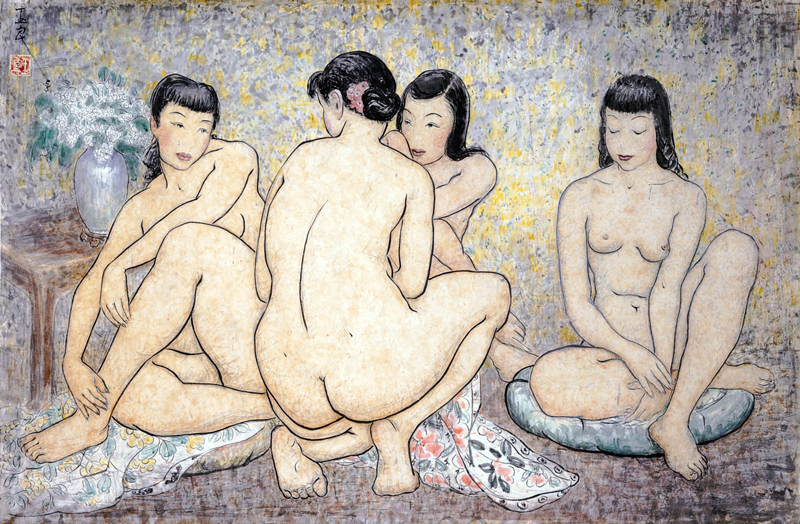|


Pan
Yuliang Biography
Pan Yuliang's complicated life gets more plentiful
after her participation in art, with her defying and fending
characteristics and through movies and teleplays, the world could
rediscover her talent and her art. In 2006 spring, her solo exhibition
"Pan Yuliang - the painting soul" was held in National Museum of History
and National Taiwan Museum of Fine Arts, through 120 paintings, her life
and her art were clearly displayed, and the Pan Yu-liang fever is on the
rise.
 As
one of the earliest Chinese painters in France, Pan Yu-liang had great
passion and her talent; she is one of the best Chinese artists in the past
century. With Shanghai professor Hong Ye's enlightenment and the principle
in Shanghai Art School Liu Haisu, teacher Wang Jiyuan's support, she
successfully enrolled to Sino-French Institute, Ecole Nationale des
Beaux-Arts de Lyon, Ecole des Beaux-Arts de Paris, and National Arts
Institute in Rome, and her pursuing knowledge clearly shows the steadfast
and persevering will she has. She was an illiterate person who loves to
embroider, but after graduation, she was appointed to the director of
Shanghai Art School and the professor of National Nanjing University. Like
what Liu Haisu said, Pan Yuliang is a "warrior of beauty" in her life.
After she went to Europe, she participated countless French Salon
exhibitions and had received French National Gold Award (1945), Belgium
Brussels Sliver Prize (1958), Paris prix d'Or (1959), and medaille
d'Honneur de la Societe' Encouragement au Progres (1971). Her life had
been documented in "Dictionnaire des peintres, sculpteurs, dessinateurs et
graveurs" and French "Dictionnaire de la peinture Larousse". As
one of the earliest Chinese painters in France, Pan Yu-liang had great
passion and her talent; she is one of the best Chinese artists in the past
century. With Shanghai professor Hong Ye's enlightenment and the principle
in Shanghai Art School Liu Haisu, teacher Wang Jiyuan's support, she
successfully enrolled to Sino-French Institute, Ecole Nationale des
Beaux-Arts de Lyon, Ecole des Beaux-Arts de Paris, and National Arts
Institute in Rome, and her pursuing knowledge clearly shows the steadfast
and persevering will she has. She was an illiterate person who loves to
embroider, but after graduation, she was appointed to the director of
Shanghai Art School and the professor of National Nanjing University. Like
what Liu Haisu said, Pan Yuliang is a "warrior of beauty" in her life.
After she went to Europe, she participated countless French Salon
exhibitions and had received French National Gold Award (1945), Belgium
Brussels Sliver Prize (1958), Paris prix d'Or (1959), and medaille
d'Honneur de la Societe' Encouragement au Progres (1971). Her life had
been documented in "Dictionnaire des peintres, sculpteurs, dessinateurs et
graveurs" and French "Dictionnaire de la peinture Larousse".
She devoted her life to art, had been pursuing the ideal of "combining
Chinese and western paintings into one", and that's how Pan Yuliang paved
her own artistic style, she had outstanding performances in oil, ink
paintings, sketches and sculptures, accomplished a cross-boundary
achievement. Especially her oil paintings concealed the essence of eastern
ink paintings, with glamorous and elegance, well arranged colors and vivid
lines. Her ink paintings has precise brush stroke, energetic lines, and
she even bravely adopted the post-impressionism techniques, to enrich the
expressions in her ink paintings. Pan Yuliang was acclaimed as the
"Master of western paintings in China", and many art critics agreed with
that after her visit to Europe. Famous Sinologist and art historiographer
in French, Vadime Elisseeff (1918-2002) commented Pan Yuliang's work: "Her
paintings combined with advantaged from both Chinese and western
paintings, she, however, had given personal characteristics to the colors.
Her sketches have Chinese traditional strokes, with vivid lines to
describe the softness and freedom of the entity, and this is Pan Yuliang's
unique style. Her oil paintings concealed with techniques from Chinese
traditional ink paintings, she used pure and fresh colors to embellish
the picture, the color depths and density lives closely to the lines, and
naturally revealed the distance, the light and shade, the false and true
or the picture, which is living and vivid-Kher using the brush of Chinese
calligraphy to paint the world has become one of the contributions to the
art history. ", and Michael Sullivan, the art historiographer from
England, also praised Pan Yuliang as "one of the only few extraordinary
Chinese painters who is able to meld Chinese and western art beautifully
".
Most of Pan Yu-liang's work are collected in the China Anhui Museum,
however, some are also collected in China National Museum of Fine Arts,
French Musee Cernuschi de Paris, Musee de la ville de Paris, National
Educational Institute of France, and Taipei Fine Arts Museum. Among them,
the Anhui Museum collection is major come from the artist's legacy, with
a total of over 4000 pieces, there are 361 oil paintings, 393 ink
paintings, 3892 sketches, drafts, manuscripts, 4 sculptures, 6 engravings
and 13 block prints included. Except from the museum collections, there
are only 10 oil paintings in the market, that's why her works are
precious.
The high peak of her oil painting creations laid between 1937 and 1942,
the second time, her revisiting France. Since then she concentrated on the
study of Chinese paintings, meld the characteristics of lines with the
features in Pointillism and Fauvism to create a brand new style, she even
asked for advice from Chang Ta-Chien, and learn from each other by
exchanging views; on the other hand, she also began to sculp, that's how
she developed her nude paintings with sculpture features during the
1950's, and achieved another peak in her artistic life.

"Nude" was finished in 1951; the artist is in her
mature stage of the development in melding oil and ink paintings, during
that time, the amount of her oil painting creations gradually reduced,
because she was more into the study of ink paintings. The background of
this painting reflects the white space concept in eastern paintings, used
darker lines to draw the outline of back of the nude lady. Women's body is
the most elements in the artist's life. Before her attending to Shanghai
Art School, the principle was upbraided as the "traitor in the art scene"
because of his nude painting exhibitions, and he was also charged by the
warlord because of his model teachings. And during her study in Shanghai
Art School, she paid more attention on nude paintings; she even painted in
women's public shower rooms, and got cursed and beaten. However, she never
gave up nude paintings because of this; she was more confirmed about it.
She even painted her own nude in the mirror in those conservative years.
With a bias on painting nudes, she has more freedom after she went to
Paris.
On one hand, because she was trained by European academies, and enthroned
this spirit of classical paintings; on the other hand, she seemed trying
to liberate women's long-time suppressed status, to reverse her
frustration and unfair treatments in the past, what's why she prefer to
paint women nudes. Her paintings doesn't carry any sexual descriptions,
they bear social criticisms and human concerns, displays an attitude
towards self celebration.
Except from the influences from the classical academy trainings, Pan
Yuliang's paintings are in general influenced by the master of Fauvism,
Matisse, there are brightly colored chair cushions serve as a contrast
next to the nude. Especially by portraying the "backs" of women as the
symbol of perseverance and the strength of life, she also emphasizes the
quantity in the sculptures with the lines and brush strokes on the
shoulders and arms. She also placed the bottom of the nude in the center
of the picture; it's also one of her unique arrangements. Her modeling of
the nudes can be easily associated with Renoir's nudes. Even though they
were living in different eras, like Renoir, Pan Yu-liang also chosen fat
women as subjects, they both had their unique way to display the sheen on
the skin, to praise the wonder of women body. The arrangement in this red
"Nude" imitates what western masters did, the lines concealed the
brightness of the east, and Pan Yu-liang used her unique crossing lines to
set off lights and shades, it is a very successful and representative
work.
|